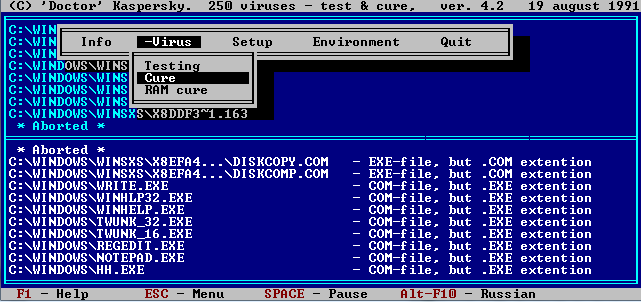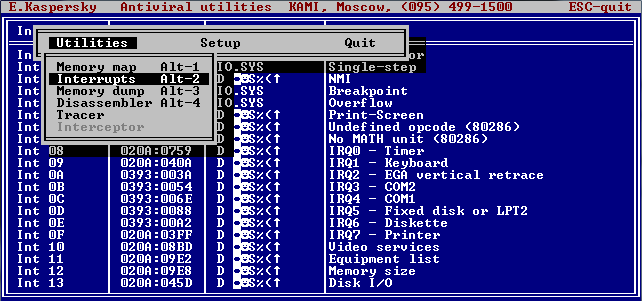July 7, 2011
A Blast from the Past. Part II – the AV Artefact.
And here we are, with the second in the series of nostalgic tales from the history of the company. As promised, in this installment we are taking you on a journey back to the beginning of the 90s – to the era of good old DOS, and the prototype of our anti-virus, which was used on this early operating system.
Generally my first encounter with viruses came in October 1989. (In just a few months it will be 22 years since that fateful event, and I still don’t know how to celebrate this anniversary!). It all started with someone bringing me a floppy disc (when they actually were floppy!) containing a strange program that caused a bizarre effect of falling characters. I had a look at the program, dug into it, felt around, and eventually cured it. This satisfied me greatly and I was most happy with the result. And I enjoyed the process of doing it too.
I began successfully treating other viruses that kept being brought to me, and soon news about my virus cures spread all around the research institute I was studying at the time. It was around this time that I generally became known as the “the guy who gets rid of viruses”. Then folk with viruses started coming from other departments, then other institutes, and then other cities.
If you were to ask how many viruses I’ve healed in my career, I’d have to answer that I don’t know. But I guess it wouldn’t be all that many – both relatively and in real terms. Starting in 2006 we saw a big leap in the number of new malicious programs, which doubled each year to reach 20 million samples in 2010. By that time we already had one of the strongest anti-virus laboratories in the world, but I was no longer involved in the virus analysis cycle, concentrating instead on the business development.
But getting back to the early days, my utility used to treat the very first virus gradually started to develop and improve in appearance. Each new virus strain was carefully analyzed and added to the database of the program. However, I’m afraid to say that the utility got no further than my own computer. The first version, which I thought would be appropriate to be released for free circulation, carried the laconic title “-V” and was distributed in 1990-1991 freely on diskettes (not that much Internet around that time!).
See more artefacts
So, what was the mysterious “-V” all about? Not all that mysterious really. It contained two marketing concepts: The first was semantic: “minus V”, i.e., to subtract the viruses. The second was related to priority in lists – a minus sign always appeared at the beginning of a character set (and in a list of products in a comparative test).
The public release – version 4.2 – was able to find and cure 250 boot and file viruses. Oh and how simple the life of the virus analyst was back then – but with snail’s pace results! We were able to indulge ourselves and spend two or three days analyzing each sample, and the idea of introducing automation systems was not even considered.
See more artefacts
And what names we gave the viruses! Eddie-651, Fumanchu-2080, V-512, Vienna-757, XPEH-3872, etc. So how did they get their names? Quite simple: the prefix we took from the body of the virus or its visual manifestation (for example, the “Eddie” family contained the line “Eddie lives…somewhere in time”, referring to British heavy metal group Iron Maiden’s trusty and long-standing mascot, Eddie, and its album Somewhere in Time). The second part gave the length of the virus in bytes. Can you imagine a tiny 1800-byte program (to compare, an empty Word document contains 12 000 bytes!) that included a memory resident interceptor with self-protection capabilities against anti-viruses and an extremely dangerous payload that wipes out disk sectors? Neither could we!
One element of the product was the classic on-demand scanner of that period, by then presented in ASCII art, that supported a mouse, and that had a multi-language interface and built-in help. It served as the control center for two other programs – “-UTIL” (a collection of system utilities for manual analysis of unknown viruses) and “-D” (a resident anti-virus monitor).
See more artefacts
Another cause for pride was our virus encyclopedia. This was supplied in standard text files and was presented as a fount of knowledge for understanding how to combat infections. Here were presented the history of malicious programs, classifications, precautionary measures, a glossary, and detailed descriptions of all viruses. By the way, in the year 2000, it became the basis for our knowledge base Viruslist, now known as Securelist – an authoritative resource for IT security news and analytics.
It gives me pleasure to present to you a short video with a screen-cast of -V. One and a half minutes taking you back 20 years into the past and showing you the gigantic steps we have taken in this time in terms of development.
And now, fasten your seatbelts. We are ready to travel back in time: you can download the very same first version of -V which started it all – directly via this link!
And with this link – you can find the next version, which provided protection from 270 viruses and contained the virus encyclopedia.
Important note: the program was created almost 20 years ago. I can’t guarantee its stable operation on modern computers and operating systems. Use at your own risk!
Useful links:
A Blast from the Past. Part I – the Pack-shot Odyssey





